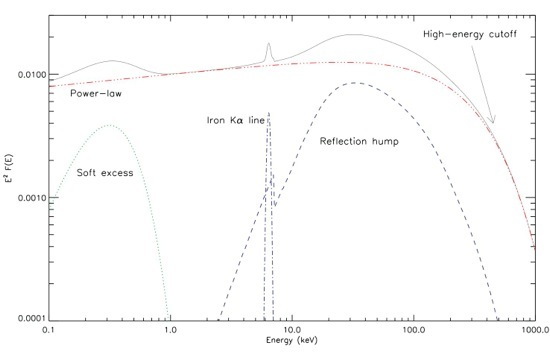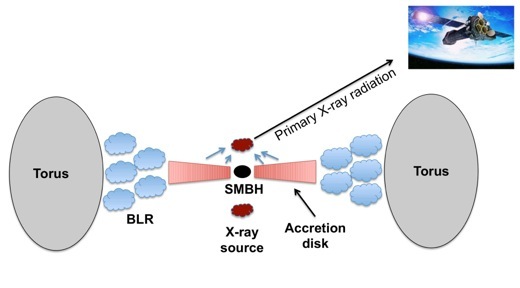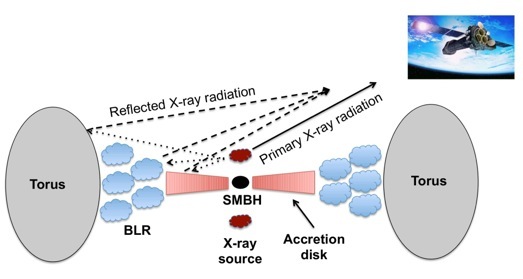







AGN in the X-ray band
Fig. 3 The typical 0.1-1000 keV spectrum of an unabsorbed AGN
If you use this image please refer to Ricci et al. 2011, PhD thesis.

A large fraction of AGN show an excess over the power-law continuum below ~2 keV. This Soft excess has a different origin for absorbed and unabsorbed AGN. In the case of unabsorbed objects, several interpretations have been given: blurred reflection from an ionized disk, smeared absorption by an ionized wind, or a second cooler corona.
Effects of absorption on the X-ray spectra of AGN
for different values of the column density NH.
If you use this video please refer to Ricci et al. 2011, PhD thesis.


X-ray emission is ubiquitous in AGN, and is believed to be produced by Comptonization of optical/UV disk photons by a corona of hot electrons (Fig. 1) located above the SMBH (e.g., Haardt & Maraschi 1991).
This Comptonization produces a power-law emission, with a photon index typically of Γ~1.8-2. The power-law continuum often shows a high-energy roll-over, which is usually located around few hundreds keV. This feature is directly related to the temperature and optical depth of the plasma of hot electrons responsible for the power-law emission.
This reprocessed radiation consists mainly of two features: a Compton hump peaking around 30-40 keV, and an iron Kα emission line at 6.4 keV. While the Compton hump is produced only if the reprocessing material is Compton thick (CT, Nh > 1e24 cm^−2), the iron Kα line can be produced also by Compton-thin material. The iron Kα line is often observed as the superposition of two components: a broad and a narrow one. While the broad component might arise from reflection from the inner part of the accretion flow, the narrow component is likely produced by material located further away (i.e. in the BLR or in the torus).
Part of the primary X-ray emission is reprocessed by the molecular torus, the BLR and the disk, giving rise to reflection features.
Fig. 1 Schematic representation of X-ray production in AGN.
If you use this image please refer to this website
Download
Fig. 2 Reprocessing of X-ray radiation in AGN
If you use this image please refer to this website
Absorption affects the X-ray emission through two processes: photoelectric absorption and Compton scattering. Photoelectric absorption starts being effective already at column densities of NH~1e21cm^-2, is energy-dependent and does not play a significant role above 10 keV for NH<1e24cm^-2 (see the video). Compton scattering becomes significant above Nh~1e+24 and does not have a significant dependence on energy below ~150 keV.







